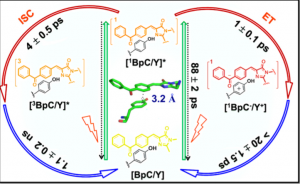CCS chemistry published a research paper entitled “Ultrafast photoinduced electron transfer in a photosensor protein” by Wang Jiangyun, researcher of Institute of Biophysics, CAS, Xia Antong, researcher of Institute of Chemistry, CAS, and Yu Longjiang, researcher of Institute of Botany. A 27 kDa photosensitive protein (PSP3), which can be encoded by the gene, was designed and reported. It has the key characteristics of the PSII system, such as primary photo-induced electron transfer. The incorporation of the benzophenone alanine (BPA) gene into PSP protein and the measurement of femtosecond transient absorption spectra showed that a highly efficient and rapid photoinduced electron transfer (~ 1 picosecond) process occurred from TYR203 to PSP3 chromophore. The light-driven generation of BPC - (E0 = - 1.47 V vs she) and y + (E0 ~ 1.34 V vs she) was realized.

In algae and plants, photosystem I (PSI) and photosystem II (PSII) work together to oxidize water to O2, reduce NAD (P) + to NAD (P) h, and finally reduce CO2 to produce carbon-based energy materials for cell growth. Scientists are committed to improving the efficiency of photosynthesis and creating artificial photosynthesis systems to promote challenging chemical transformation. However, it is still difficult to enhance the function of the photosystem directly by genetic engineering because the photosystem is a large membrane protein complex containing many cofactors. Wang Jiangyun's previous research team found that non-natural amino acids can be inserted into fluorescent protein (PSP) by using gene codon expansion technology, so as to transform the chromophore and generate species with high reducing activity (PSP2 ·, E0 = - 1.47 V). Furthermore, the introduction of small molecular nickel complexes at specific sites on the protein surface or fusion of small proteins containing iron-sulfur clusters can drive carbon dioxide photoreduction (NAT. Chem., 2018; Acc. Chem. Res.,2019; PSP protein showed excellent photochemical properties in the above work.
Based on the above research, a novel photosensitizer protein (PSP3) was designed and characterized. PSP3 includes the primary key characteristics of PSII, including 405nm visible light absorption; The ultrafast photoinduced electron transfer (PET, ~ 1 picosecond) is equivalent to that of the original PET in PSII; After absorbing light, BPC - (E0 = - 1.47 V vs she) and y + (E0 ~ 1.34 V vs she) were produced. Since PSP3 is easy to overexpress in high yield in E. coli, further effective directed evolution may contribute to the development of challenging oxidation and reduction reactions in vivo and in vitro.
Reference
Dandan Zheng, Min Tao, Longjiang Yu, et al. Ultrafast Photoinduced Electron Transfer in a Photosensitizer Protein. CCS Chemistry, 12 Jun 2021, https://doi.org/10.31635/ccschem.021.202100823